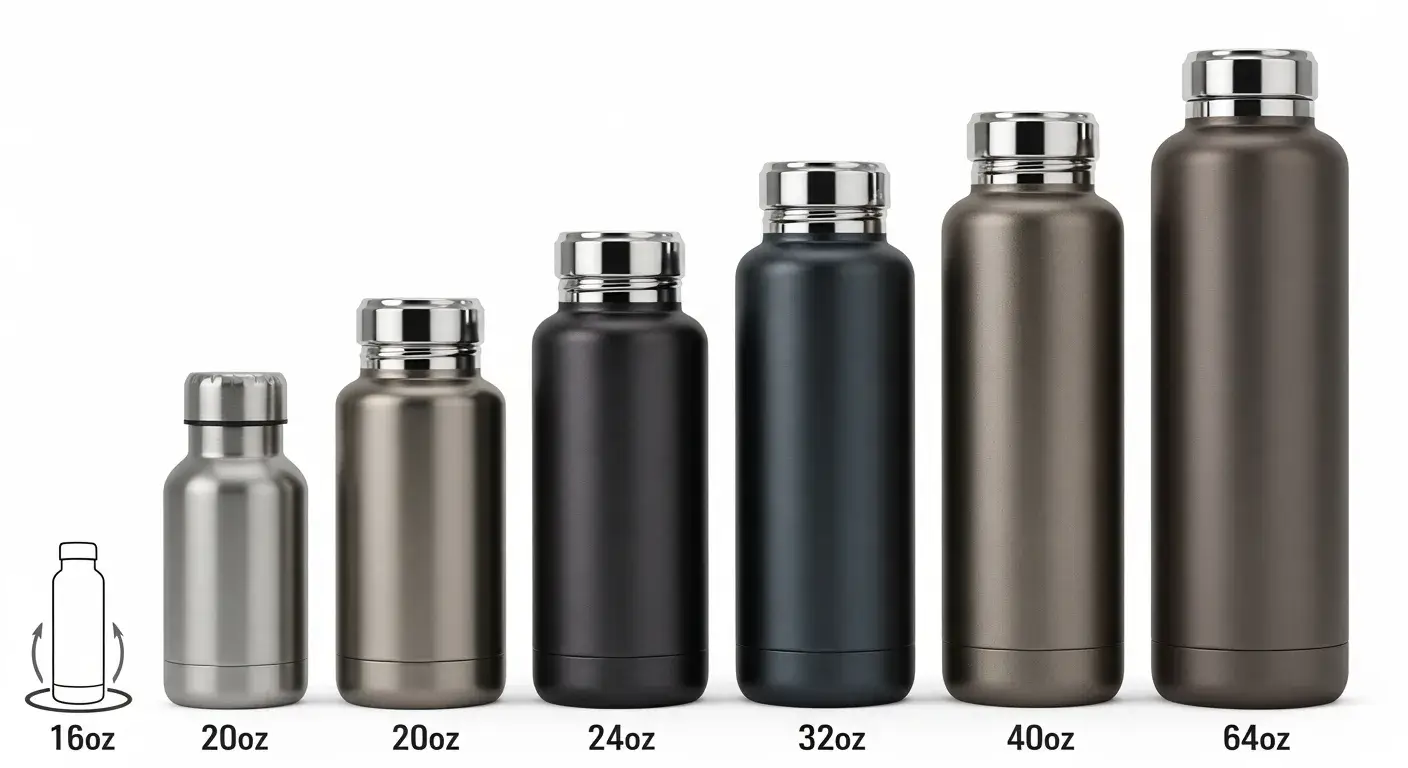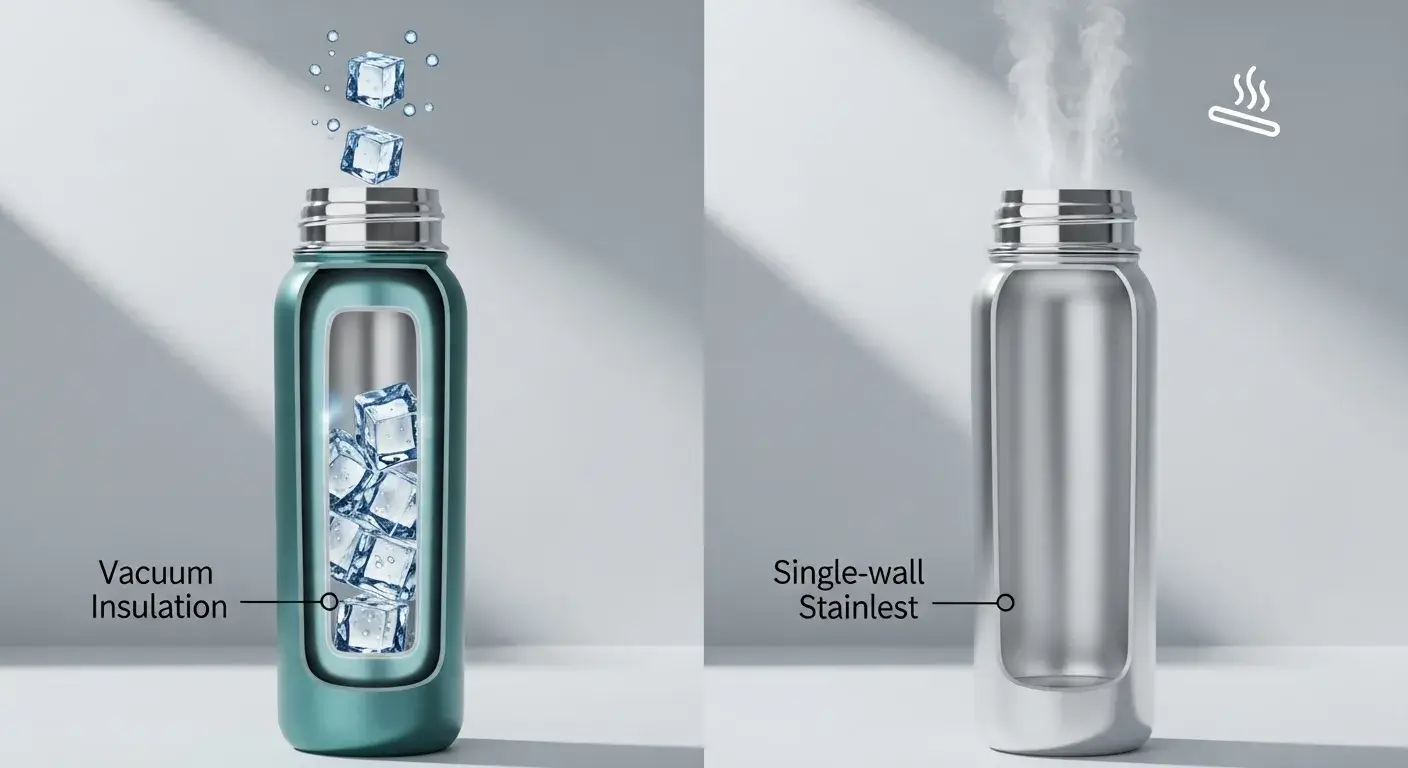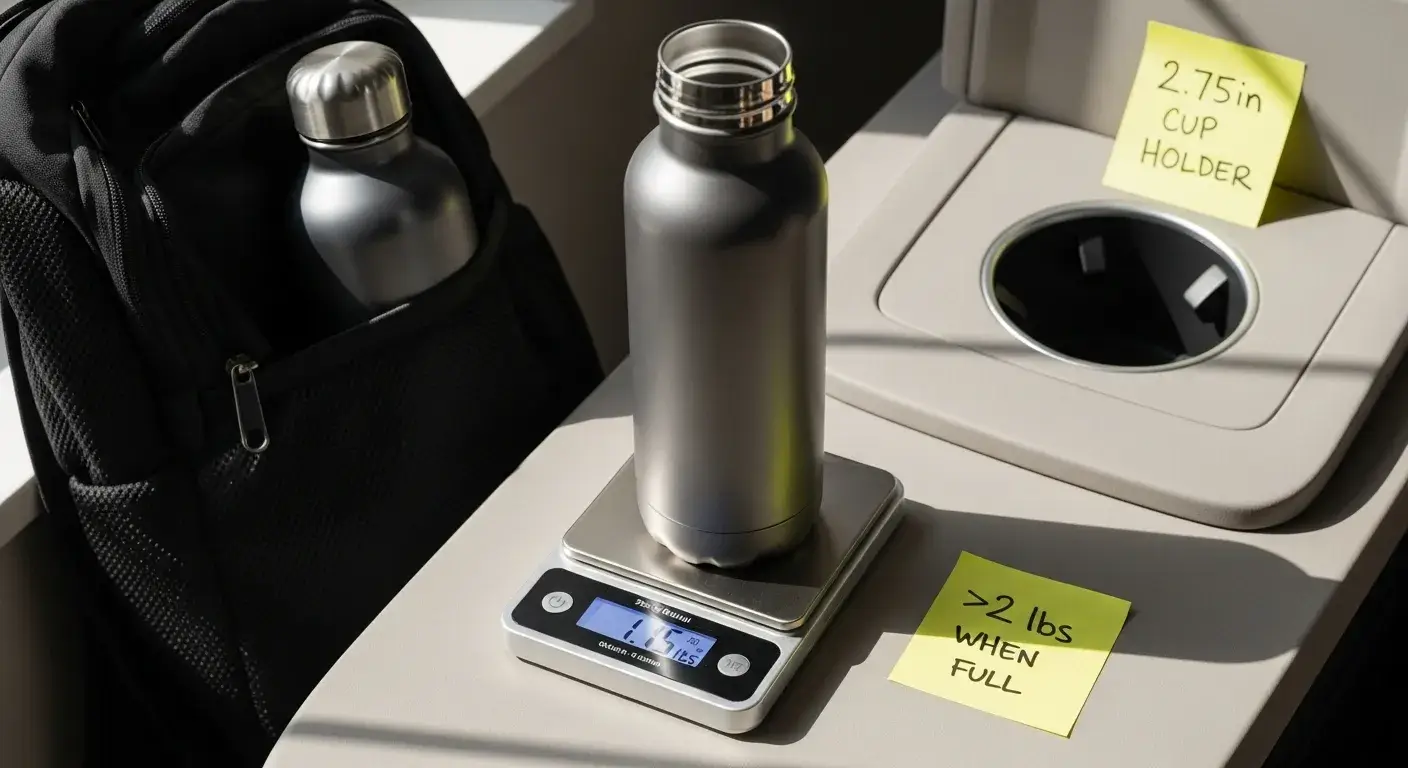
I struggled for months carrying the wrong water bottle size. Too small meant constant refills. Too big meant aching shoulders. Finding the perfect size changed my hydration game completely.
The ideal stainless steel water bottle size depends on your daily water needs and activities. Most people need 24oz for daily use, 16-20oz for office work, and 32oz for gym or hiking.
Ready to find your perfect bottle size? Let me guide you through the exact calculations and considerations that will save you from my costly mistakes.
How Much Water Do You Actually Need Daily?
My doctor's advice seemed simple until I tried tracking my water intake. Eight glasses sounds easy. Reality hit differently when I realized my small bottle required endless trips to the water fountain.
Adults need 91-125 ounces of water daily based on gender and activity level. This translates to 4-5 refills with a 24oz bottle or 3-4 refills with a 32oz bottle.

Understanding Your Personal Hydration Formula
The Mayo Clinic provides clear guidelines1 for daily water intake. Women need about 91 ounces daily. Men require 125 ounces. These numbers increase with physical activity and hot weather.
I use a simple calculation method. Take your body weight in pounds. Multiply by 0.5 to 1 ounce. A 150-pound person needs 75-150 ounces daily. Exercise adds 12 ounces per hour of activity.
Here's my practical breakdown:
| Activity Level | Base Water Needs | Exercise Addition | Total Daily Needs |
|---|---|---|---|
| Sedentary | 64-80 oz | 0 oz | 64-80 oz |
| Moderate Exercise | 64-80 oz | 12-24 oz | 76-104 oz |
| High Activity | 64-80 oz | 24-48 oz | 88-128 oz |
Hot weather increases these needs by 20-50%. I learned this during my first Arizona hiking trip when my usual 24oz bottle left me dehydrated.
Matching Bottle Size to Daily Needs
Your bottle size determines refill frequency. Fewer refills mean better hydration compliance. Too few refills with oversized bottles create carrying burdens.
A 16oz bottle requires 6 refills for 100 ounces daily. That's manageable at a desk job. Not practical during hiking or long meetings.
A 24oz bottle needs 4 refills for the same amount. This balance works for most people. The bottle stays portable while reducing refill trips.
A 32oz bottle drops refills to 3 times daily. Perfect for active people who want minimal interruptions.
What Are the Best Stainless Steel Water Bottle Sizes for Different Activities?
I own five different bottle sizes after years of trial and error. Each activity demands specific capacity and portability considerations. My collection saves me from daily hydration struggles.
Office work requires 16-20oz bottles for portability and desk fit. Gym activities need 24-32oz for sustained hydration. Hiking demands 32-40oz to minimize refill stops during long trails.

Office and Commuting Needs
My desk setup changed when I switched from a 32oz bottle to an 18oz model. The smaller bottle fits perfectly in my laptop bag's side pocket. It doesn't tip over during video calls.
Office workers benefit from 16-20oz bottles for several reasons. They fit standard cup holders in cars. The weight stays manageable during commutes. Frequent refills provide natural break reminders.
I recommend these sizes for office use:
- 16oz: Ultra-portable, fits small bags, weighs 1 pound when full
- 18oz: Sweet spot for commuters, tested by Hydrocell for daily use
- 20oz: Maximum size for most cup holders, good for long meetings
Gym and Fitness Requirements
My gym routine taught me that 24oz bottles work best for most workouts. They provide enough water for hour-long sessions without constant refills. The size fits comfortably in gym bag pockets.
Serious Eats testing confirms that 24oz bottles hold ice effectively. Cold water encourages more drinking during intense workouts. The size balances capacity with portability.
For different workout types:
- 24oz: Perfect for cardio sessions, weight training, yoga classes
- 32oz: Ideal for long gym sessions, hot yoga, CrossFit workouts
- 40oz: Necessary for marathon training, outdoor boot camps
Hiking and Outdoor Adventures
Trail hydration requires different calculations. I learned this during a 6-hour hike when my 24oz bottle left me rationing water in the final miles.
Hiking demands 32-40oz bottles minimum. The larger capacity reduces water source dependency. Many trails lack reliable refill points.
My hiking size recommendations:
- 32oz: Day hikes under 4 hours, well-marked trails with water sources
- 40oz: Full-day hikes, desert conditions, backup water needs
- 64oz (Half-gallon): Multi-day trips, group leaders, emergency situations
Travel and Transportation Considerations
Airport security and car compatibility matter more than I initially realized. My 40oz bottle caused TSA delays and wouldn't fit rental car cup holders.
Travel bottles need specific dimensions:
- Height: Under 10 inches for carry-on bags
- Diameter: 2.75 inches or less for standard cup holders
- Weight: Under 2 pounds when full for comfortable carrying
How Do Dimensions and Capacity Compare Across Popular Sizes?
I measured dozens of bottles after buying the wrong size three times. Manufacturers list capacity but ignore real-world fit issues. My dimension chart prevents costly mistakes.
Bottle dimensions vary significantly between brands and insulation types. A 24oz insulated bottle measures approximately 9.5 inches tall and 2.75 inches wide, weighing 1.5 pounds when full.

Complete Size Comparison Chart
My testing revealed major differences between advertised and actual dimensions. Insulated bottles add 0.5-1 inch to diameter measurements. This affects cup holder compatibility.
| Size | Height (inches) | Diameter (inches) | Weight Full (lbs) | Refills for 100oz |
|---|---|---|---|---|
| 16oz | 8.0 | 2.5 | 1.0 | 6 |
| 20oz | 8.5 | 2.7 | 1.25 | 5 |
| 24oz | 9.5 | 2.75 | 1.5 | 4 |
| 32oz | 10.5 | 3.0 | 2.0 | 3 |
| 40oz | 11.5 | 3.2 | 2.5 | 2.5 |
| 64oz | 12.5 | 4.0 | 4.0 | 1.5 |
Brand-Specific Variations
Different manufacturers create unique dimension profiles. Hydro Flask bottles tend toward wider diameters. Klean Kanteen offers narrower profiles for better grip.
I tested popular models for actual measurements:
- Hydro Flask 24oz: 9.4" x 2.87", fits most cup holders barely
- Klean Kanteen 24oz: 9.1" x 2.75", better cup holder fit
- Takeya 24oz: 9.8" x 2.68", tallest but narrowest profile
Weight Distribution Impact
Full bottle weight affects carrying comfort significantly. I noticed wrist strain during long carries with 32oz+ bottles. The water weight concentrates at the bottle bottom.
Weight considerations by size:
- Under 1.5 lbs: Comfortable for extended carrying
- 1.5-2 lbs: Manageable for short periods, gym bags recommended
- Over 2 lbs: Requires handles, straps, or frequent setting down
Should You Choose Insulated or Non-Insulated Stainless Steel Bottles?
My collection includes both types after learning their distinct advantages. Temperature needs and weight preferences determine the best choice. Cost differences also influence decisions.
Insulated bottles keep drinks cold for 24 hours and hot for 12 hours but add weight and cost. Non-insulated bottles weigh less and cost less but offer no temperature control.

Insulation Performance Testing
Serious Eats conducted laboratory testing on insulated bottles. Their 24oz test bottles maintained 34°F water with ice for over 24 hours. Larger bottles performed slightly better due to increased vacuum space.
My real-world testing confirms these results:
- Morning ice: Still present after 8-hour workdays
- Hot coffee: Drinkable temperature after 6 hours
- Cold water: Refreshing temperature maintained all day
Weight and Size Trade-offs
Insulation adds significant bulk and weight. My 24oz insulated bottle weighs 0.5 pounds more than the single-wall version. The diameter increases by 0.25-0.5 inches.
This affects practical use:
- Cup holder fit: Insulated bottles may not fit standard holders
- Bag storage: Wider bottles require larger pockets or compartments
- Carrying comfort: Extra weight becomes noticeable during long periods
Cost-Benefit Analysis
Insulated bottles cost $15-25 more than single-wall versions. The premium pays for double-wall construction and vacuum sealing technology.
| Feature | Single-Wall | Insulated | Winner |
|---|---|---|---|
| Weight | Lighter | Heavier | Single-Wall |
| Cost | Lower | Higher | Single-Wall |
| Temperature | Room temp | Controlled | Insulated |
| Durability | Good | Excellent | Insulated |
| Versatility | Limited | High | Insulated |
Best Use Cases for Each Type
My experience suggests clear winners for different situations:
Choose insulated bottles for:
- Gym workouts requiring cold water
- Hot beverage consumption
- Outdoor activities in temperature extremes
- All-day hydration with temperature preference
Choose single-wall bottles for:
- Office use with room temperature water
- Weight-sensitive activities like running
- Budget-conscious purchases
- Frequent cleaning requirements
What Factors Like Weight and Fit Should You Consider When Selecting Size?
I learned about hidden factors the hard way. My first bottle choice ignored car compatibility. The second didn't fit my backpack properly. These oversight cost money and created daily frustrations.
Consider bottle weight when full, cup holder compatibility, bag fit, cleaning ease, and long-term durability when selecting your ideal size. These factors often matter more than capacity alone.

Weight and Carrying Comfort
Full bottle weight surprised me initially. Water weighs 8.34 pounds per gallon. A 32oz bottle holds 2 pounds of water plus bottle weight. This creates carrying challenges during extended periods.
I developed weight tolerance guidelines:
- Under 1.5 lbs total: Comfortable for all-day carrying
- 1.5-2.5 lbs: Good for short periods, gym bags, car use
- Over 2.5 lbs: Requires handles, frequent setting down
Vehicle and Equipment Compatibility
Car cup holder testing revealed critical compatibility issues. Standard U.S. cup holders accommodate 2.75-inch diameters. European cars often use smaller dimensions.
My compatibility checklist:
- Measure your car's cup holders before purchasing
- Test backpack pockets with similar-sized objects
- Consider office desk space for bottle placement
- Check gym locker dimensions for storage fit
Cleaning and Maintenance Requirements
Larger bottles create cleaning challenges. Wide mouths help but increase bottle diameter. Narrow bottles require bottle brushes for proper cleaning.
Maintenance considerations by size:
- 16-24oz: Easy hand washing, fits most sinks
- 32oz: Requires bottle brushes, challenging in small sinks
- 40oz+: Needs large sinks, specialized cleaning tools
Long-term Value Assessment
My cost-per-use calculations justify premium bottles. A quality stainless steel bottle lasts 5-10 years with proper care. This replaces thousands of plastic bottles.
Environmental impact factors:
- Stainless steel recycling2: 90% post-consumer content available
- Plastic replacement3: One bottle eliminates 300+ plastic bottles yearly
- Lifecycle cost: $0.10-0.20 per use over 5 years
Budget Considerations Across Sizes
Price varies significantly by size and features. Basic 24oz bottles start around $20. Premium insulated models reach $45-50.
Budget planning by size:
- 16-20oz: $15-35, good starter investment
- 24oz: $20-45, most versatile price range
- 32oz+: $25-55, premium investment for serious users
My value recommendations prioritize durability over initial cost savings. Quality bottles with NSF food safety certifications4 justify higher prices through longevity and performance.
Conclusion
Choose 24oz for daily versatility, 16-20oz for office portability, or 32oz+ for active lifestyles based on your specific hydration needs and carrying preferences.
-
Official Mayo Clinic guidelines provide medically-backed recommendations for daily water intake based on gender, activity level, and environmental factors to help you determine your personal hydration needs. ↩
-
Learn how stainless steel bottles contribute to environmental sustainability through recyclability and reduced plastic waste, with data on post-consumer recycled content and manufacturing processes. ↩
-
Research-backed information on how switching to reusable stainless steel bottles significantly reduces plastic waste, with statistics on annual plastic bottle replacement and environmental impact reduction. ↩
-
NSF International food equipment standards ensure your stainless steel water bottle meets safety requirements for materials, construction, and performance, protecting against harmful chemicals and contaminants. ↩

